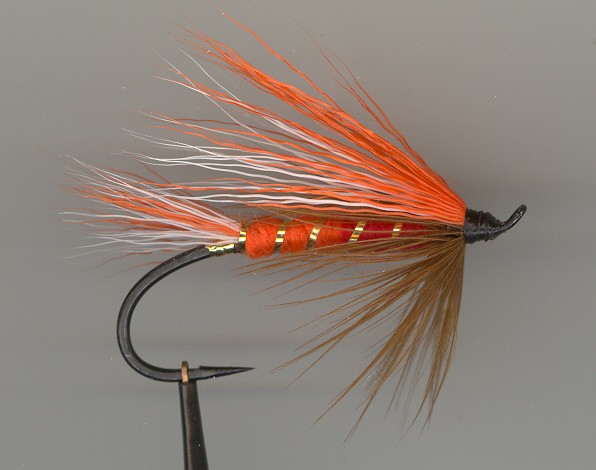
On The Fly
"Fly tying is a school from which we never graduate"
TYING NEWSThe Southern Oregon Fly Tiers met Wednesday, December 14 at the library in Gold Hill. There was a fly raffle and fly exchange along with tying demonstrations. We had several new tiers drop by for a fun evening. A lot of valuable knowledge was exchanged at no charge.The next meeting will be on January 11th. Please join us the second Wednesday of each month for more fun and the sharing of the art.
 PATTERN OF THE MONTH - Brad's Brat
PATTERN OF THE MONTH - Brad's Brat
Hook: Steelhead size 6 to 4/0
Thread: Black, 6/0
Tag: Flat or oval gold tinsel
Tail: White or orange bucktail or kid goat
Body: Rear 1/2: orange yarn; front 1/2: red wool yarn
Rib: Flat or oval gold tinsel
Collar: Brown hackle
Wing: Orange over white bucktail or kid goat
Head: Black thread
Tying Instructions:
1) Start the thread at a position on the hook shank that allows the proper
room for the head. Use this as a marker and don't tie anything past this
mark.
2) Wrap a thread base to a position just above the hook point; tie in the
tinsel at this point.
3) Wrap the tinsel three turns forward to form a tag. Tie off but don't trim
the tinsel. You will need the tinsel for the rib.
4) Tie in the orange and white fur to form the tail just in front of the tag.
The tail should be 1/2 the length of the shank.
5) Tie in the orange wool yarn and wind it forward 1/2 the body length. Tie
it off and trim It.
6) Tie in the red wool yarn and wind it forward the rest of the body. Tie it
off and trim it.
7) Rib the body with 5 or 6 turns of the gold tinsel then tie off and trim
the tinsel.
8) Tie in and wind three turns of brown hackle.
9) Tie in a small clump of white hair in front of the hackle. Make the wing
the length of the body.
10) Tie in a small clump of orange hair on top of the white.
11) Form a neat thread head and apply cement.
The summer and winter races of steelhead go about their
migrations with very different agendas. Summer fish migrate in leisurely
manner, taking all summer and fall to get around to the actual spawning.
Winter fish, on the other hand, get right up to the spawning grounds and get
with the program of reproducing. Winter fish enter the system sexually
mature and ready to spawn while summer fish must mature sexually while in
the system.
With this in mind the steelheader must change tactics
departing from the classic dry-line, wet-fly swing and adopt techniques
that fish the fly closer to the holding level of the winter fish. Winter
conditions cause streams to change quickly due to heavy rains or snow melt.
Fly choice must match the prevailing conditions but still remains a personal
preference. We rarely have the opportunity to test the fish's comparative
response to different patterns. Therefore we tend to choose a fly based on
our confidence or knowledge that getting the fly in front of a steelhead's
face is more important than the particular pattern. John Shewey says "Just
choose a fly that is reasonable and then fish that fly with diligence and
confidence. A reasonable fly for an off-color, swollen winter stream might
differ considerably from a reasonable fly for that same stream during a
low-water period."
Newcomers to steelhead fishing might be overwhelmed by the
endless patterns available. What color works best on any particular stream
under what particular conditions? The answer may be as simple as asking more
questions. Call your local fly shop or one of the many helpful RFF members.
Most would gladly share their knowledge and experiences.
This month's pattern, Brads Brat, was devised by Enos
Bradner and introduced on Washington rivers around 1937. This classic
hairwing design continues to be a popular and effective winter steelhead
pattern. Tie some up, give them a test flight and let me know how you do.
Tie One On,
Dan Kellogg (you can contact me at FLYGUY@EZNORTHWEST.COM)